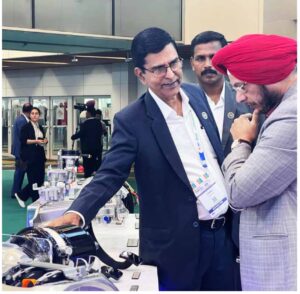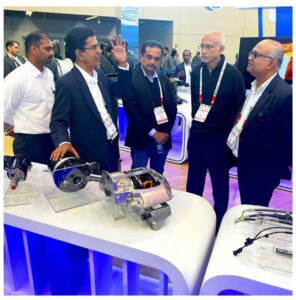Brakes India has solidified its dominance in the commercial vehicle segment, holding over 70% market share. Most commercial vehicles in India rely on our braking systems, with several customers sourcing exclusively from us. Our comprehensive product range, covering vehicles from 2 to 60 tons, includes foundation brakes and specialized components like retarders. In an exclusive interview with Bus Coach India Magazine, D. Sridharan, President & Head of the Heavy Vehicles Business Unit, shares insights on the company’s roadmap for the commercial vehicles business.
Q: How do you see the market trend in the commercial vehicle industry, specifically for braking systems in India?
Over the past six years, Brakes India has firmly established itself as a dominant player in the commercial vehicle segment, currently holding over 70% of the market share. In fact, most commercial vehicles manufactured in India are equipped with our braking systems, and for several customers, we are their sole supplier.
Our extensive product portfolio caters to the entire spectrum of braking requirements, ranging from foundation brakes to specialized components such as retarders. We take pride in being the only company in India that offers a comprehensive product range capable of serving vehicles from 2-ton to 60-ton capacity. Furthermore, we have recently developed a cutting-edge pneumatic braking system, further strengthening our ability to provide full-package solutions tailored for commercial vehicles.
Q: What is your market outlook for 2025 and beyond? Do you have any specific growth projections?
For the financial year 2024–25, we expect the commercial vehicle industry to witness moderate growth, fluctuating between 3% to 5%. This variation is largely due to macroeconomic factors and fluctuations in demand across different segments. However, we anticipate an improvement in the following year, primarily driven by increased government spending on infrastructure projects and a general positive shift in economic conditions.
Given that commercial vehicle demand is closely linked to overall economic activity, we foresee steady growth in the sector, with a projected increase of approximately 5% in 2025. The long-term outlook remains positive, especially with the push for enhanced logistics infrastructure and urban mobility projects.

Q: How is the demand trend across different segments like haulage and buses?
The haulage segment faced a slowdown in the first half of 2024 but is now showing signs of recovery. A notable trend in this segment is the gradual shift from rigid trucks to trailer segments, which we expect to see continued growth in the coming years.
On the other hand, the bus segment has experienced sustained demand, primarily fueled by pent-up demand from the COVID-19 period. Various urbanization initiatives, including metro expansions and public transport enhancements, have contributed to this growth. Given the rising focus on mass transportation, we expect the demand for buses to remain strong for the foreseeable future.
Q: Safety is a major concern, especially for buses. What braking technologies are you implementing to enhance safety?
In Europe, disc brakes have already become the standard, while in India, the transition is still underway. The bus segment has been a frontrunner in adopting disc brakes, and currently, we supply around 500 disc brakes per month to major OEMs. Our product range covers sizes from 17.5 inch to 22.5 inch, and we have also developed our proprietary single-piston disc brake technology.
While cost remains a challenge, the total cost of ownership for disc brakes is gradually decreasing, which will encourage wider adoption in the future. In the electric vehicle (EV) sector, disc brakes have already become the norm. Additionally, we lead the market in retarders—an auxiliary braking system that enhances vehicle safety and extends the life of tires and brake linings. We supply retarders to leading manufacturers such as Tata Motors, Ashok Leyland, and Volvo Eicher, solidifying our position as the number-one player in this segment.
Q: Are you incorporating AI technology into braking systems to enhance safety?
We have been actively investing in AI-driven driver assistance systems. One of our key developments is an AI-powered driver monitoring system that tracks eye movements and physical gestures to detect signs of fatigue or distraction. This technology is ready for deployment, and we anticipate that upcoming regulations in 2027 will likely mandate such features.
Additionally, we are engaged in extensive research and development for autonomous driving systems. Our teams are working on multiple projects that involve AI-driven safety features and automation technologies, which will play a crucial role in the future of commercial vehicle safety.
Q: What investments have you made in manufacturing capacity and R&D for pneumatic braking systems?
We made significant investments to expand our production capacity, specifically for pneumatic braking systems. We established a dedicated plant located 50 kilometers from our Karapakkam facility, specializing in the production of these advanced braking solutions.
To date, we have invested approximately INR 100 crore in the plant infrastructure and an additional INR 150 crore in technology development, amounting to a total investment of INR 250 crore in pneumatic braking systems. This investment underscores our commitment to innovation and manufacturing excellence.
Q: What is your focus on the EV segment, particularly for electric buses?
The electric bus segment has been one of the earliest adopters of advanced braking systems. We supply braking solutions to all major EV bus manufacturers, including startups such as Evage and Electra. Additionally, our braking systems are widely used in electric buses manufactured by major OEMs like Switch Mobility, covering both 9-meter and 12-meter electric bus models.
Given the increasing focus on sustainable urban mobility, we see the EV bus segment as a key driver for future growth. Our goal is to continue developing state-of-the-art braking solutions tailored for electric and autonomous vehicles.

Q: What are the biggest challenges you face in the marketplace?
One of the primary challenges in the braking system industry is balancing technological advancements with cost-effectiveness. Customers demand high-tech solutions, but at the same time, they expect competitive pricing. Striking the right balance between innovation and affordability remains our biggest challenge.
Additionally, evolving safety regulations and the rapid transition towards electric and autonomous vehicles require continuous investment in R&D. While we are well-equipped to handle these challenges, maintaining our leadership position requires ongoing adaptability and strategic investments.
Q: How much does Brakes India invest in R&D, and what is your research focus?
Brakes India is deeply committed to research and development, allocating approximately 3–5% of our annual turnover towards R&D initiatives. Our in-house test track, which has been operational for over two decades, plays a critical role in testing and validating new products.
Currently, our R&D division employs over 250 engineers who focus on advancing braking technologies for both light and commercial vehicles. Our primary areas of research include next-generation disc brakes, AI-integrated safety features, and braking solutions optimized for electric and autonomous vehicles.
Q: Is Chennai the primary hub for Brakes India’s operations?
Chennai serves as our R&D hub and houses our mother plant. In addition, we have a commercial vehicle brake plant in Sholingur, a foundry in Jaghadiya, Gujarat, and another manufacturing plant in Jamshedpur. These strategically located facilities allow us to remain close to our customers and cater to their specific needs efficiently.
Q: What is the total production capacity of Brakes India?
Our overall turnover, including our foundry operations, is approximately INR 7,000 crore. In terms of production capacity, we can manufacture up to 250,000 brakes per month. At present, we are operating at around 200,000 brakes per month, with the flexibility to scale up production as required.
Q: Any final thoughts on the future of braking systems in India?
The future of braking systems in India is evolving rapidly, driven by increasing safety regulations and the rise of electric vehicles. We foresee significant growth opportunities in AI-integrated braking solutions and autonomous vehicle technologies. Brakes India remains committed to innovation and cost efficiency, ensuring that we continue to lead the market in providing cutting-edge braking solutions.